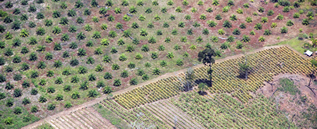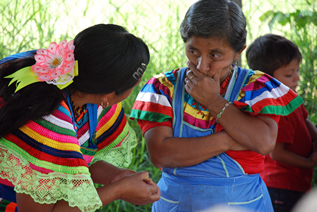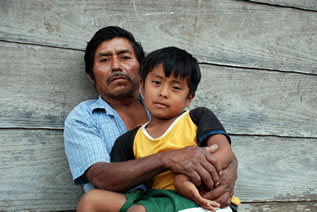For Immediate Release 21 September 2011
(Español debajo)
Washington, DC – As the World Bank, the largest source of multilateral financing for forestry projects, [1] prepares for its fall meetings here, Global Justice Ecology Project charges that the Bank’s promotion of the controversial forest-carbon scheme called REDD (Reducing Emissions from Deforestation and Forest Degradation) harms both forests and forest dependent communities in developing countries, while encouraging continued pollution in vulnerable communities in developed countries like the U.S.
Following the announcement of a new sub-national REDD agreement between the states of California, USA, Chiapas, Mexico and Acre, Brazil during the UN Climate Conference in Cancun last December, Global Justice Ecology Project launched an investigation into the potential on-the-ground impacts of REDD. In March and April of 2011, GJEP traveled to Chiapas to investigate social and ecological impacts of the REDD project there, which is being designed to create carbon offset credits by quantifying the carbon stored by trees in the Montes Azules Biosphere Reserve in the Lacandon Jungle.
“During our investigation, we went to the community of Amador Hernandez, deep in the jungle,” stated Orin Langelle, from Global Justice Ecology Project. “The villagers reported to us that the Mexican government was withholding medical services as a means to pressure them to leave. If they refused, they feared the Mexican military would force them to leave, as has happened to other Indigenous communities in the Lacandon jungle.” [2]
Environmental justice groups also warn that REDD agreement will have detrimental impacts on people in California. “The carbon offsets from this REDD agreement are going to allow people in places like Richmond and Wilmington, California to continue to be polluted and sickened by polluting industries like the Chevron and Tesoro oil refineries,” said Joaquín Quetzal Sánchez, Oakland, California-based Strategist for CrossRoots: Building a Sustainable Movement.
“This REDD agreement will harm communities on all sides of the border. The only ones that win are the polluters,” Sanchez said. [3]
In October, GJEP will travel to Acre, Brazil to meet with groups concerned about the REDD project there, and to document the actual and potential impacts of the project. GJEP plans to bring representatives from Chiapas to this meeting to further opportunities for cross-border strategizing regarding the California-Chiapas-Acre REDD deal.
The effort to “protect forests” by removing the people that depend on them contradicts recent studies that demonstrate forests are best protected when the communities depending on them have legal title. In a six-year study, CIFOR (the Center for International Forestry Research) found that, “Tropical forests designated as strictly protected areas have annual deforestation rates much higher than those managed by local communities”. [4]
The World Bank has been involved in the global forest/climate program known as REDD through its Forest Carbon Partnership Facility[5], announced by World Bank President Robet Zoellick, during the 2007 UN Climate Conference in Bali, Indonesia. The announcement met with strong popular protest, and the World Bank continues to draw sharp criticism for its role in promoting schemes that displace forest dependent communities and promote large-scale industrial tree plantations that could potentially include socially and ecologically dangerous genetically engineered trees. [6] [7]
Today is the International Day of Action Against Monoculture Tree Plantations. Last year GJEP released this video highlighting their concerns about tree plantations and genetically engineered trees.
Contacts:
Anne Petermann, Executive Director, Global Justice Ecology Project; North American Focal Point, Global Forest Coalition +1.802.578.0477 (on site in Washington, DC)
Jeff Conant, Communications Director, Global Justice Ecology Project, +1.575.770.2829
Joaquin Sanchez, CrossRoots, +1 917.575.3154
###
Notes to Editors
[1] World Bank Forests and Forestry Issue Brief: http://web.worldbank.org/WBSITE/EXTERNAL/NEWS/0,,contentMDK:20103458~menuPK:34480~pagePK:34370~piPK:34424~theSitePK:4607,00.html
[2] “Turning the Lacandon Jungle Over to the Carbon Market,” Z Magazine, July 2011: http://www.zcommunications.org/turning-the-lacandon-jungle-over-to-the-carbon-market-by-jeff-conant
[3] The California Report: AB32 and Environmentalists: http://www.californiareport.org/archive/R201103220850/a
[4] 2011 Center for International Forestry Resarch (CIFOR) report: Community managed forests and forest protected areas: An assessment of their conservation effectiveness across the tropics
[5] The World Bank maintains three roles in the Forest Carbon Partnership Facility. It is one of the main international climate initiatives set up to fund developing country REDD schemes.
[6] http://noredd.makenoise.org/
Para publicación inmediata
21 septiembre, 2011
Esquemas de carbono forestal del Banco Mundial acusados de adelantar la contaminación en el Norte Global, desplazando a las comunidades en el Sur Global
Washington, DC – Mientras el Banco Mundial, que es la mayor fuente de financiamiento multilateral para proyectos forestales, [1] se prepara para tener sus reuniones de otoño, el Proyecto por la Justicia Ecológica Global (Global Justice Ecology Project) acusa que la promocion por esta institución de la controversial plan conocido como REDD (Reducción de Emisiones por Deforestación y Degradación) esta perjudicando tanto a los bosques y las comunidades dependientes de los bosques en los países en desarrollo, y fomentando al mismo tiempo la contaminación continua en las comunidades más vulnerables en los países desarrollados como los EE.UU.
Tras el anuncio de un nuevo acuerdo sub-nacional de REDD entre los estados de California, EEUU, Chiapas, México y Acre, Brasil, durante la Conferencia Climática de la ONU en Cancún en diciembre pasado, el Proyecto por la Justicia Ecológica Global (GJEP) inició una investigación sobre los impactos potenciales y actuales de REDD. En marzo y abril del 2011, GJEP viajó a Chiapas para investigar los impactos sociales y ecológicos del proyecto REDD, que está siendo diseñado para crear créditos de compensación de carbono mediante la cuantificación del carbono almacenado por los árboles en la Reserva de la Biosfera Montes Azules en la Selva Lacandona.
“Durante nuestra investigación fuimos a la comunidad de Amador Hernández, en la selva profunda”, dijo Orin Langelle, del Proyecto por la Justicia Ecológica Global. “Los aldeanos nos informaron de que el gobierno mexicano está utilizando la retención de servicios médicos como un medio para presionarlos para que abandonen sus tierras. Tienen miedo de que al negarse abandonar sus tierras los militares mexicanos les obliguen a salir por la fuerza, como ha sucedido con otras comunidades indígenas en la selva Lacandona. “[2]
Grupos de justicia ambiental también advierten que el acuerdo REDD tendrá un impacto negativo en la población de California. “La compensación de carbono a partir de este acuerdo REDD va a seguir permitiendo la contaminación de comunidades como Richmond y Wilmington, California, causadas por refinerías de petróleo como Chevron y Tesoro”, dijo Joaquín Quetzal Sánchez, estratega basado en Oakland, California y parte del grupo CrossRoots: Construyendo un Movimiento Sostenible.
“Este acuerdo de REDD dañará las comunidades en ambos lados de la frontera. Los únicos que ganan son los que contaminan”, dijo Sánchez [3]
En octubre, GJEP viajará a Acre, Brasil, para reunirse con los grupos interesados en el proyecto REDD en ese lugar y para documentar los impactos reales y potenciales del proyecto. GJEP planea traer a representantes de Chiapas a este encuentro para crear nuevas oportunidades y establecer estrategias transfronterizas en relación con el acuerdo sobre REDD en California-Chiapas-Acre.
La idea de “proteger los bosques” mediante la expulsión de las comunidades que dependen de ellos contradice estudios recientes que demuestran que los bosques están mejor protegidos cuando aquellas comunidades que dependen de ellos tienen títulos de propiedad. En un estudio de seis años, el CIFOR (Centro para la Investigación Forestal Internacional) encontró que, “Los bosques tropicales designados como áreas de protección tienen las tasas anuales de deforestación mucho más altas que aquellas administradas por las comunidades locales” [4]
El Banco Mundial ha estado involucrado en el programa global forestal/climático conocido como REDD a través de su “Forest Carbon Partnership Facility” [5], anunciado por el presidente del Banco Mundial Robet Zoellick, durante la Conferencia Climática de la ONU en 2007 en Bali, Indonesia. El anuncio fue recibido con fuertes protestas populares, el Banco Mundial continúa atrayendo duras críticas por su papel en la promoción de esquemas que desplazan a las comunidades dependientes de los bosques y al mismo tiempo promover grandes plantaciones industriales de árboles que podrían afectar socialmente y ecológicamente por este tipo de árboles genéticamente modificados. [6] [7]
Hoy es el Día Internacional de Acción Contra los “Monocultivos” de Árboles. GJEP publicó el año pasado este video destacando su preocupación por las plantaciones de árboles y árboles de ingeniería genética.
Contactos:
Anne Petermann, Directora Ejecutiva, Proyecto por la Justicia Ecológica Global; North American Focal Point, Global Forest Coalition +1.802.578.0477 (localizada en Washington, DC)
Jeff Conant, Director de Comunicación, Proyecto por la Justicia Ecológica Global, +1.575.770.2829
Joaquín Sanchez, CrossRoots, +1.917.575.3154
###
Notas:
[1] World Bank Forests and Forestry Issue Brief: http://web.worldbank.org/WBSITE/EXTERNAL/NEWS/0,,contentMDK:20103458~menuPK:34480~pagePK:34370~piPK:34424~theSitePK:4607,00.html
[2] “Turning the Lacandon Jungle Over to the Carbon Market,” Z Magazine, July 2011: http://www.zcommunications.org/turning-the-lacandon-jungle-over-to-the-carbon-market-by-jeff-conant
[3] The California Report: AB32 and Environmentalists: http://www.californiareport.org/archive/R201103220850/a
[4] 2011 Center for International Forestry Resarch (CIFOR) report: Community managed forests and forest protected areas: An assessment of their conservation effectiveness across the tropics
[5] The World Bank maintains three roles in the Forest Carbon Partnership Facility. It is one of the main international climate initiatives set up to fund developing country REDD schemes.


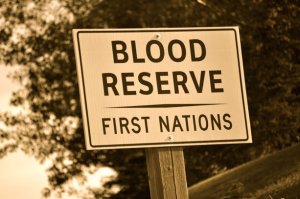
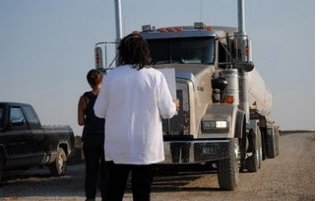 Early [September 9, 2011] numerous women from the Blood Nation have courageously parked in front of Murphy Oil’s fracking development site vowing not to move until plans of fracking for oil and gas are stopped. The women are part of the Kainai Earth Watch and have been active advocates to stop the fracking due to the major threat to human health, wildlife and livestock and the irreversible damage to the land and water on the Blood Reserve and surrounding areas. They feel this is the only choice left to them to stop the operations as plans for construction begin tomorrow [September 10, 2011].
Early [September 9, 2011] numerous women from the Blood Nation have courageously parked in front of Murphy Oil’s fracking development site vowing not to move until plans of fracking for oil and gas are stopped. The women are part of the Kainai Earth Watch and have been active advocates to stop the fracking due to the major threat to human health, wildlife and livestock and the irreversible damage to the land and water on the Blood Reserve and surrounding areas. They feel this is the only choice left to them to stop the operations as plans for construction begin tomorrow [September 10, 2011]. Since that time local residents of the Blood Nation and surrounding communities have come together to oppose the projects. Members of the KaiNai Earth Watch have partnered with numerous community groups, including the Lethbridge Council of Canadians, to host numerous educational workshops, organize petitions, and meet with government officials. Despite their efforts, nothing has been effective in actually preventing the fracking from going ahead.
Since that time local residents of the Blood Nation and surrounding communities have come together to oppose the projects. Members of the KaiNai Earth Watch have partnered with numerous community groups, including the Lethbridge Council of Canadians, to host numerous educational workshops, organize petitions, and meet with government officials. Despite their efforts, nothing has been effective in actually preventing the fracking from going ahead.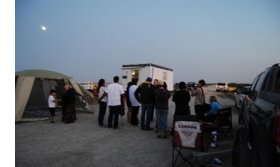 The second issue at hand is the nature of the deal between KRI, Murphy Oil, and Bowood Energy. We believe this to be highly problematic for a number of reasons:
The second issue at hand is the nature of the deal between KRI, Murphy Oil, and Bowood Energy. We believe this to be highly problematic for a number of reasons: